The ASUS Maximus VIII Impact Z170 ROG Mini-ITX Motherboard Review
by Ian Cutress on December 29, 2015 9:00 AM ESTGaming Performance 2015
Our 2015 gaming results for Z170 are still relatively new, but the issue of FCLK settings might play a big role here. At launch, the default setting for the communication buffer between the CPU and PCIe stack was 800 MHz, even though Intel suggested 1000 MHz, but this was because of firmware limitations from Intel. Since then, there is firmware to enable 1000 MHz, and most motherboard manufacturers have this - but it is unclear if the motherboard will default to 1000 MHz and it might vary from BIOS version to BIOS version. As we test at default settings, our numbers are only ever snapshots in time, but it leads to some interesting differences in discrete GPU performance.
Alien: Isolation
If first person survival mixed with horror is your sort of thing, then Alien: Isolation, based off of the Alien franchise, should be an interesting title. Developed by The Creative Assembly and released in October 2014, Alien: Isolation has won numerous awards from Game Of The Year to several top 10s/25s and Best Horror titles, ratcheting up over a million sales by February 2015. Alien: Isolation uses a custom built engine which includes dynamic sound effects and should be fully multi-core enabled.
For low end graphics, we test at 720p with Ultra settings, whereas for mid and high range graphics we bump this up to 1080p, taking the average frame rate as our marker with a scripted version of the built-in benchmark.
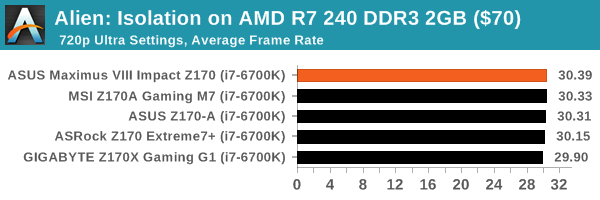
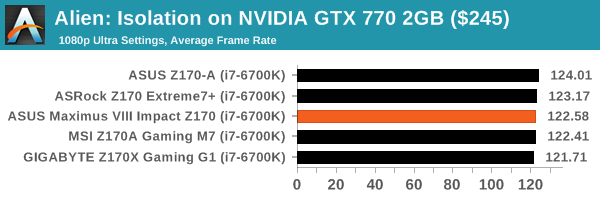
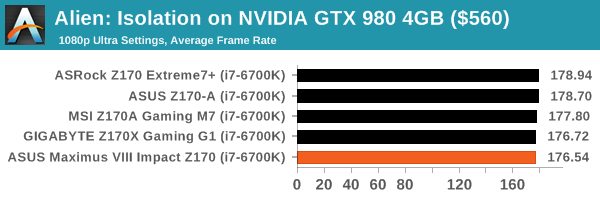
Total War: Attila
The Total War franchise moves on to Attila, another The Creative Assembly development, and is a stand-alone strategy title set in 395AD where the main story line lets the gamer take control of the leader of the Huns in order to conquer parts of the world. Graphically the game can render hundreds/thousands of units on screen at once, all with their individual actions and can put some of the big cards to task.
For low end graphics, we test at 720p with performance settings, recording the average frame rate. With mid and high range graphics, we test at 1080p with the quality setting. In both circumstances, unlimited video memory is enabled and the in-game scripted benchmark is used.
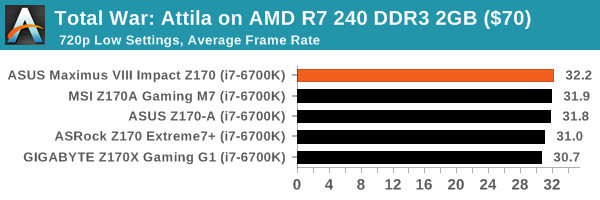
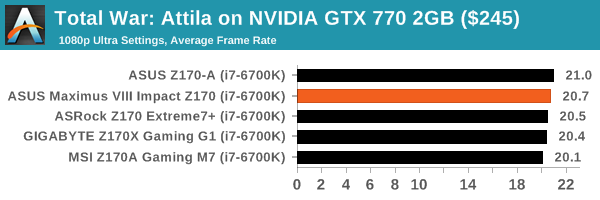
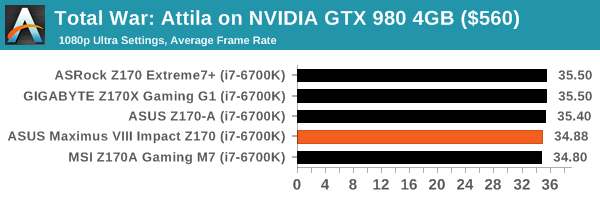
Grand Theft Auto V
The highly anticipated iteration of the Grand Theft Auto franchise finally hit the shelves on April 14th 2015, with both AMD and NVIDIA in tow to help optimize the title. GTA doesn’t provide graphical presets, but opens up the options to users and extends the boundaries by pushing even the hardest systems to the limit using Rockstar’s Advanced Game Engine. Whether the user is flying high in the mountains with long draw distances or dealing with assorted trash in the city, when cranked up to maximum it creates stunning visuals but hard work for both the CPU and the GPU.
For our test we have scripted a version of the in-game benchmark, relying only on the final part which combines a flight scene along with an in-city drive-by followed by a tanker explosion. For low end systems we test at 720p on the lowest settings, whereas mid and high end graphics play at 1080p with very high settings across the board. We record both the average frame rate and the percentage of frames under 60 FPS (16.6ms).
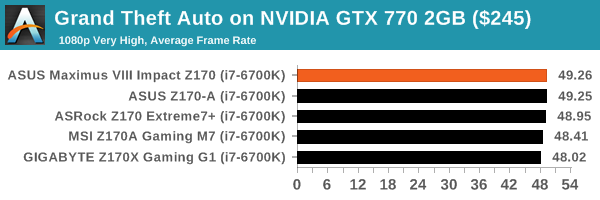
GRID: Autosport
No graphics tests are complete without some input from Codemasters and the EGO engine, which means for this round of testing we point towards GRID: Autosport, the next iteration in the GRID and racing genre. As with our previous racing testing, each update to the engine aims to add in effects, reflections, detail and realism, with Codemasters making ‘authenticity’ a main focal point for this version.
GRID’s benchmark mode is very flexible, and as a result we created a test race using a shortened version of the Red Bull Ring with twelve cars doing two laps. The car is focus starts last and is quite fast, but usually finishes second or third. For low end graphics we test at 1080p medium settings, whereas mid and high end graphics get the full 1080p maximum. Both the average and minimum frame rates are recorded.
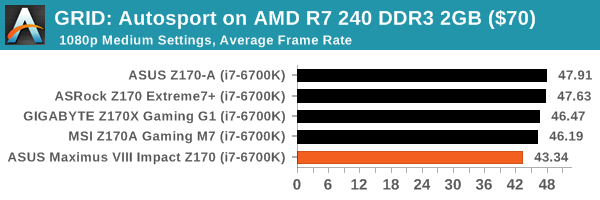
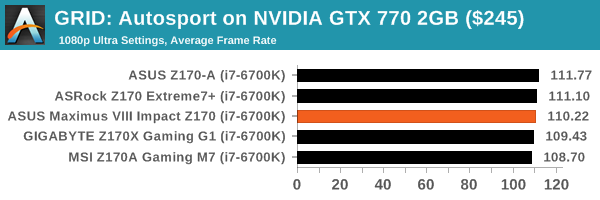
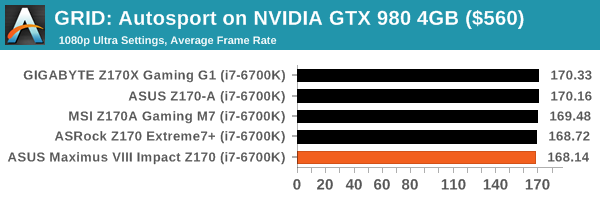
Middle-Earth: Shadow of Mordor
The final title in our testing is another battle of system performance with the open world action-adventure title, Shadow of Mordor. Produced by Monolith using the LithTech Jupiter EX engine and numerous detail add-ons, SoM goes for detail and complexity to a large extent, despite having to be cut down from the original plans. The main story itself was written by the same writer as Red Dead Redemption, and it received Zero Punctuation’s Game of The Year in 2014.
For testing purposes, SoM gives a dynamic screen resolution setting, allowing us to render at high resolutions that are then scaled down to the monitor. As a result, we get several tests using the in-game benchmark. For low end graphics we examine at 720p with low settings, whereas mid and high end graphics get 1080p Ultra. The top graphics test is also redone at 3840x2160, also with Ultra settings, and we also test two cards at 4K where possible.

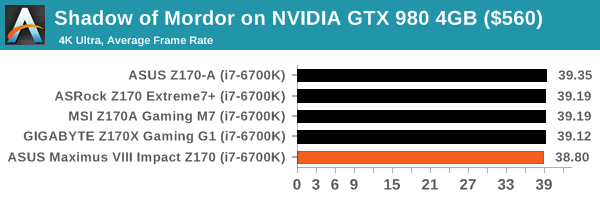















42 Comments
View All Comments
FelixDraconis - Wednesday, December 30, 2015 - link
Agreed with Mr. Elmore, but let me clarify. I'm a game programmer, myself. No, I do not have a college degree. I started too early for that. Writing clean documentation for others is one of the most important things I strive for. Picking good metaphors is also of vital importance. All things very similar to writing tech articles.Sure, some of my comments may be pedantic, but I'd rather have feedback than silence from my audience. I just hope that Mr. Ian will ponder them and decide to improve. We stop living when we stop learning. Anyway, I really just wanted to help. Anandtech is one of the best websites out there for tech articles and probably a great career builder.
Personally speaking, I stopped reading the text because it was hard to decipher. So, I suspect others would, too. Kind of defeats the purpose of writing it. Good luck, Mr. Ian!
mapesdhs - Wednesday, December 30, 2015 - link
Felix, personally I find your comments most welcome, better writing should be encouraged. Brevity is in short supply these days.SpartyOn - Tuesday, December 29, 2015 - link
I'm waiting for Nvidia Pascal to drop before updating my mini ITX Asus P8Z77-i Deluxe Ivy Bridge system. This review will heavily influence my opinion when it comes time to purchase. Looks pretty good to me.TheSlamma - Tuesday, December 29, 2015 - link
Ugh, Killer network cards SUCK Intel all the way homejasonelmore - Tuesday, December 29, 2015 - link
Asus never use Killer network cards, that's a MSI thing.. All Asus ROG boards use Intelmapesdhs - Wednesday, December 30, 2015 - link
I bought an MSI gaming laptop which has Killer E2400/wifi, works very well IMO. Far better wifi range than I've ever had before with a laptop, good GigE speeds too.mapesdhs - Wednesday, December 30, 2015 - link
Back in the Z97 era, I was pondering a Maximus VII IMPACT, but in the end I bought the ASUS Z97I-Plus instead, and very happy I am with it too. Many of the same features, cheaper, etc.Reading this article, I wondered if there was a S1151 equivalent; well, almost, namely the H170I-PLUS D3. Ian, Iike these top-end miniITX reviews, but it'd be nice to compare to something a bit further down the range. Afterall, the M8I doesn't have M.2, whereas the Z97I-Plus, and the newer H170I-Plus D3 both do have it, so the latter is surely worth of consideration.
mapesdhs - Wednesday, December 30, 2015 - link
(rats, still no edit function! Can we please make that a priority for AT in 2016? I meant to say, I like these top-end miniITX reviews, etc.)legolasyiu - Tuesday, January 5, 2016 - link
Ian, I bet your POST time will be better if you upgrade BIOS to 1302,Maximus VIII Impact BIOS 1302
1. Improve system stability
Visual - Wednesday, January 6, 2016 - link
Fun times, when "low end" gets to run 30fps on ultra, be it on a "low" resolution (that's still classified as HD, mind you).And the cherry on top is that even IGPs can finally do that, now if only they actually were put into some products... I wonder, why Intel seems to be purposely hiding the good Iris chips?